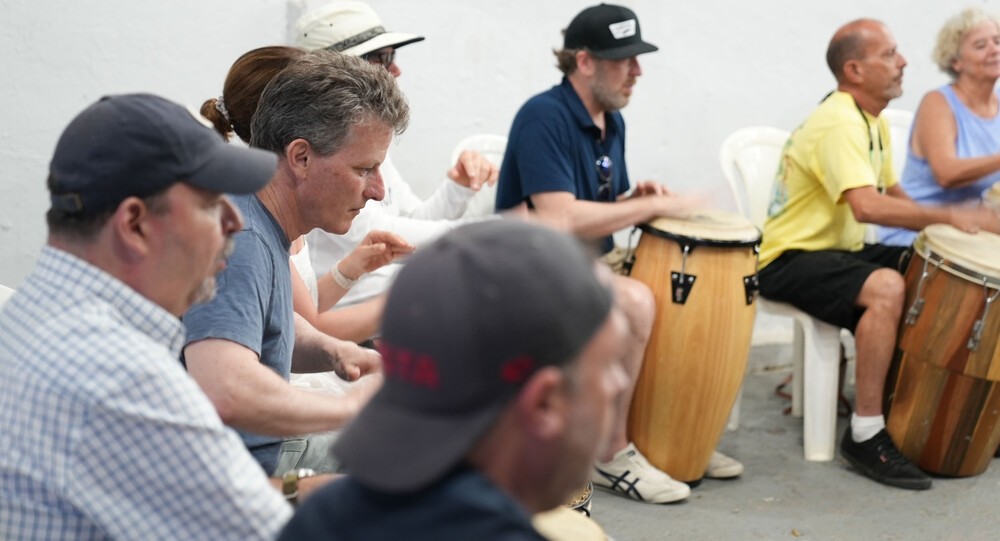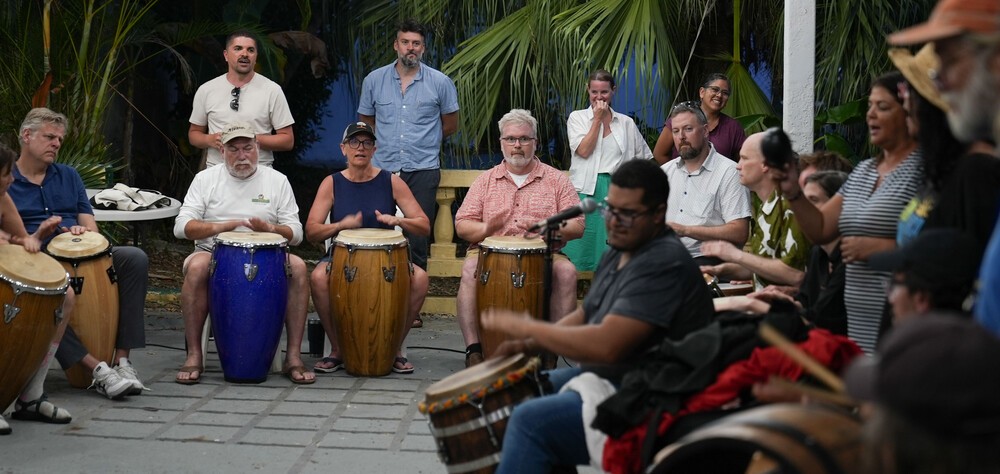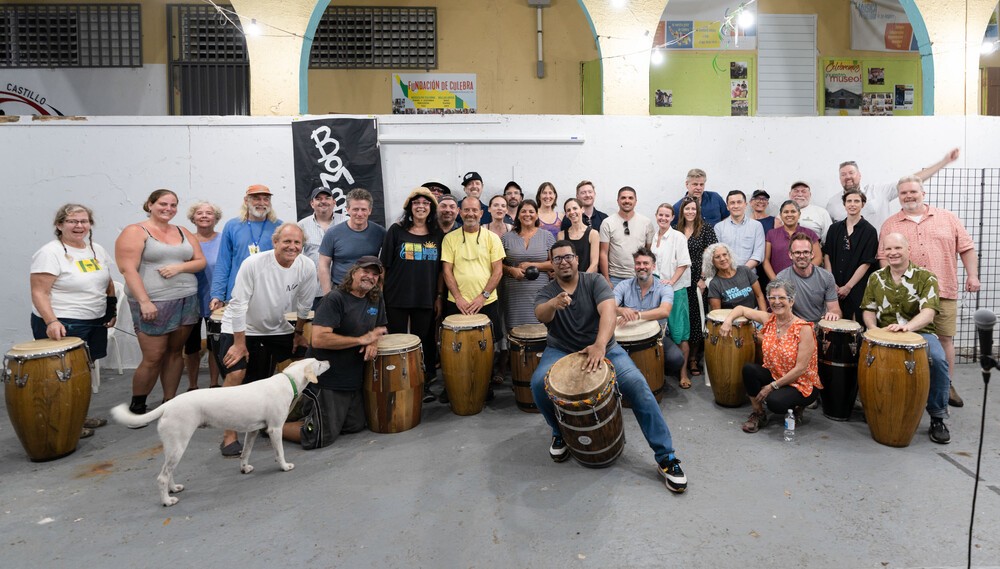Bomba Puertorriqueña
O cómo 25 arquitectos aprendieron sobre liderazgo practicando este ritmo.
Durante el más reciente Retiro Marvel, la mejor actividad para entender dinámicas de liderazgo y crear relaciones entre directores y socios, sorprendentemente ocurrió durante una clase de música tradicional puertorriqueña, específicamente la bomba puertorriqueña, ofrecida por la Fundación de Culebra y su programa Música Pa' Culebra.
Planificado como una sorpresa por nuestro director fundador, Jonathan Marvel, llegamos a la escuela, y de repente éramos veinte arquitectos, de diferentes partes del mundo y diferentes orígenes culturales, con instrumentos extraños entre nuestras piernas, creando ritmos desconocidos con nuestras manos.
De los profesores, aprendimos sobre el género, su historia y su actualidad. La bomba, que ha sobrevivido y se ha conservado prácticamente sin cambios durante más de 400 años, fue creada desde la esclavitud, principalmente en las zonas costeras de la isla, como el único medio de expresión y comunicación. Comunicaba alegrías y tristezas, eventos pasados y futuros, bodas y nacimientos, rebelión e insurrección. No era una práctica religiosa, sino cultural.
La bomba, un género principalmente de percusión y baile, se practica con cinco (5) elementos / instrumentos principales: barriles (subidor o primo y buleador o segundo), cuás (palos de madera), una maraca, un cantante y una bailaora (bailarín). Hay ocho ritmos básicos, de los cuales se derivan otros ritmos, en más de 40 otros. En aras del tiempo, aprendimos tres de ellos: sicá, yubá y cuembé.
En su sentido más básico, los cuás, la maraca, el cantante y los barriles buleadores crean un fondo musical para la "conversación" que se producirá entre la bailaora (o bailaor) y el barril subidor. A diferencia de muchos otros estilos y géneros, en la bomba, la bailaora, tras entrar en primer plano con un saludo reverencial al subidor, comienza a indicar con movimientos elegantes pero firmes (piquetes) el ritmo que debe seguir el subidor. De esta manera, los instrumentos siguen al bailarín, y no al revés. Solo en algunas ocasiones, el barril subidor devuelve al bailarín al ritmo del resto de los instrumentos que se tocan, manteniendo la "conversación" amplia entre todos.
En nuestra lección, éramos en su mayoría buleadores y algunos cantantes (de apoyo) y bailaores.

Además de ser extremadamente divertido, durante nuestro retiro, encontramos paralelos entre nuestro proceso de diseño colaborativo y la práctica de este ritmo complejo, variado e impetuoso, llamado bomba.
Mientras la mayoría de los participantes trabaja al unísono (buleadores, cuás, maraca, cantor), para mantener un ritmo de fondo constante, a través de simples toques de sus instrumentos, estos apoyan el esfuerzo de unos pocos por destacar una concepción vibrante y majestuosa. El producto del diseño intencional puede ser la creación de unos pocos, pero solo se convertirá en una pieza majestuosa con el apoyo y la colaboración del todo.
Al mismo tiempo, el mensaje es elevado por la relación interactiva y cercana que puede darse entre la iniciativa controlada pero espontánea e instintiva de un personaje central (bailaora) y la hábil respuesta y apoyo de un líder experimentado (subidor). El reto del primero al segundo se convierte en la conexión principal, y a su vez genera la creación final.
Un profundo conocimiento de cada componente, por parte de líderes, permitirá el control adecuado y preciso del instrumento principal y el resultado final de la obra. (Las habilidades del subidor solo se enseñarán a los estudiantes una vez que hayan dominado todos los demás elementos del género).
En Marvel, entendemos que la colaboración deliberada trasciende las barreras culturales y las diferencias lingüísticas. Mientras que, para otros, esto puede parecer un camino seguro hacia la cacofonía, para Marvel es una oportunidad que conduce a hermosas creaciones que serían inalcanzables a través de un diseño personalizado o en silos.
Durante el resto de los días y horas de nuestro retiro, la bomba se convirtió en una metáfora constante de la discusión y la acción:
-
Al colaborar como un grupo practicando al mismo ritmo, podemos avanzar en las iniciativas de los líderes potenciales.
-
Aspiramos a tener más bailaores, cuya iniciativa y constancia propongan retos y generen conexión con los líderes, que orienten hacia y para la creación del buen diseño.
-
Como líderes que hemos practicado las diversas fases de la arquitectura, estamos entusiasmados por elevar a los próximos “bailaores”.
Siendo Marvel una firma multidisciplinaria, con prácticas en Nueva York (NY), Richmond (VA), Barcelona (ESP) y San Juan (PR), nuestra circunstancia multicultural es obvia, pero sobre todo gratificante. Posiblemente, no había mejor manera para que nuestro equipo de liderazgo abrazara las fuertes y profundas raíces del trasfondo cultural de Marvel San Juan. Pero recibir y elaborar colectivamente conclusiones tan constructivas, pertinentes y aplicables de una lección a su vez divertida, fue más que nada, invaluable.
//
Bomba, or how 25 architects learned about leadership by playing this rhythm.
During the most recent MARVEL Retreat, the best activity to understand leadership dynamics, intentional design, and create relations between directors and partners, surprisingly occurred during a class of traditional Puerto Rican music, specifically Puerto Rican bomba, offered by the Fundación de Culebra and its Música Pa' Culebra program.
We arrived at the school, a surprise planned by our founding principal, Jonathan Marvel, and suddenly we were twenty architects, from different parts of the world and different cultural backgrounds, beating instruments between our legs and creating unknown rhythms with our hands.
From the teachers, we learned about the genre, its history and its actuality. Bomba, a musical form unchanged for over 400 years, originated during slavery, predominantly in the island's coastal areas, serving as the primary means of expression and communication. It conveyed a spectrum of emotions, from joy and sorrow to past and future events, spanning weddings, births, rebellion, and also uprising. It was not a religious practice, but a socio-cultural need.
The bomba, a genre mostly of percussion and dance, is practiced with five main elements/instruments: wood barrels (subidor or primo and buleador or segundo), cuás (wooden sticks), a single maraca, singers, and a bailaora (dancer). There are eight basic rhythms, from which other rhythms are derived, into more than 40. In the interest of time, we practiced three of them: sicá, yubá and cuembé.
In its essence, the cuás, maraca, singers, and barrels create a musical backdrop for the "conversation" between the bailaora (traditionally a woman) and the barrel subidor. Unlike many other music styles, in bomba, the bailaora takes the lead, indicating rhythms to the subidor through elegant but firm movements of her shoulders, arms, and the flowy long skirt (called piquetes), which the subidor interprets and follows. The instruments follow the dancer's lead, not the other way around. Occasionally, the barrel subidor steers the dancer back to the rhythm, keeping the larger "conversation" flowing with the rest of the instruments.
In our own lesson, we were mostly buleadores (supporting barrels), some singers (supporting background), and bailaores.
Besides being extremely fun, we found parallels to our own collaborative design process from practicing this complex, varied and impetuous rhythm called bomba.

While the bulk of participants work in unison (buleadores, cuás, maraca, singer), to keep the background rhythm going and steady through simple touches of their instruments, the whole supports the effort of a few to stand out in a vibrant and majestic conception. The product of intentional design may be the creation of a few but will only become a majestic piece with the support and collaboration of the whole.
At the same time, the interactive and close relationship that can occur between the controlled but spontaneous and instinctive initiative of a central character (bailaora) and the skillful response of an experienced leader (subidor) elevates the message. The challenge from the first to the second becomes the main connection, and in turn generates the final magnificent creation.
A leader’s profound knowledge of each component will warrant the proper and precise control of the main instrument and the result of the final piece. (The subidor’s skills will only be taught to students once they've mastered all the other elements of the genre.)
At Marvel, we understand that deliberate collaboration transcends cultural barriers and language differences. While to others, this may seem a sure path to cacophony, to Marvel it is an opportunity leading to beautiful creations that would be unattainable through personalized or siloed design.
During the rest of the days and hours of our retreat, bomba became a constant metaphor for discussion and action:
-
By collaborating as a group playing at the same pace, we can advance the initiatives of potential leaders.
-
We aspire to have more "bailaores", whose initiative and steadiness propose challenges to, and generate a connection with, leaders, who will guide to and for the creation of good design.
-
Being leaders who have practiced the various phases of architecture, we are enthusiastic to elevate the next ”bailaores”.
As a multidisciplinary firm with practices in New York (NY), Richmond (VA), Barcelona (ESP) and San Juan (PR), Marvel’s multicultural circumstance is obvious, but it is mostly gratifying. Possibly, there was no better way for the leadership team to embrace the strong and deep roots of Marvel San Juan’s cultural background. But collectively receiving such constructive, pertinent, and applicable takeaways from also a very enjoyable lesson was, more than anything, invaluable.
